Katamari Damacy and the Democratization of Objects
Video games, by design, are the product of multiple objects acting together under a common set of rules. Game objects in the majority of games tend to fall into two categories: interactive and noninteractive. Interactive objects could be anything from an ammo pickup in a first person shooter to a movable block in a Zelda game. Noninteractive objects are, simply enough, every other object. It could be terrain, a building, a static npc, or a score readout; noninteractive objects are completely non interactive.
Katamari Damacy, a Playstation 2 game released in 2004, breaks down the idea of an interactive/noninteractive dichotomy. This equalization of objects creates a flat ontology throughout the game. Game object ontology can fall into two distinct camps. Hierarchical ontology would be the traditional view of the world and the one most commonly seen in games. Objects fall into distinct categories and each have their own purpose and use. Flat ontology stands in direct opposition to this. In a game that utilizes this ontological mode, everything has the same use and hierarchical position as everything else. In short, use, hierarchy, and position cease to have any meaning in the world of flat ontology. When every object acts exactly the same as another object scale ceases to exist, creating an interesting world with curious implications. While not the only game to push a more object oriented idea of ontology, Katamari Damacy does so in a beautifully designed, interesting, and most importantly fun way.
Gameplay
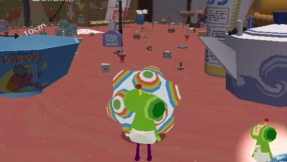
Katamari Damacy is a tough game to describe. To put it succinctly, the player controls a cosmic prince whose sole duty is to roll up objects on Earth into his giant sticky ball called a katamari. Once filled with objects, the katamari is lifted into space by the prince’s father (King of the Cosmos) who in turn makes the ball into a new star. Everything about the game helps to convey this concept. The art style is colorful and rough, with a sort of childish flair to it. The controls, while initially odd, make it truly feel like one is pushing along a ball three times your size or more. The katamari itself is the most interesting and most important part of the game. The sticky ball can pick up anything, so long as your katamari is big enough to roll over an object. The ball has no preference of one object over another, it simply breaks down the world into “can collect” and “not big enough to collect yet”. The objects that make up the game world come in more or less every conceivable shape and size, representing the totality of the objects we interact with on a daily basis.
Flat Ontology
The game creates a flat ontology in two ways. It first sets itself up by including everything into its concept of “object”. This include things as small as a paperclip to things as big as entire islands and clouds. In most games, something like the paperclip could be interactive. Much like the bobby pins in Fallout 3, player characters in other games may find use for even the smallest object.
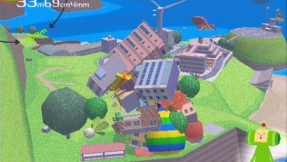
Things like islands and clouds, however, provide little to no interaction in the standard game. At best the land may serve as the floor for a level. At worst, it would serve as nothing more than background imagery. This distinction completely ceases to exist in the world of Katamari Damacy, removing the idea of scale from the equation entirely. Scale, in both life and media, helps to differentiate and contain things. In his writing on the effects of scale, Collinge states that “ once these layers [of scale] are presupposed, it is difficult not to think in terms of social relations and institutional arrangements that somehow fit their contour.” Scale bestows a hierarchy onto the objects contained within said scale, forcing objects into orders of importance. The distinct lack of scale in Katamari Damacy allows it to operate as an interesting realization on the idea of Object Oriented Ontology and an equalization of objects.
This democratization of game objects stands in stark contrast to the game objects of most other games. Take Halo for example. Ammo, enemies, and vehicles are all dynamic, interactive objects. They change, are destructible or collectible, and all have the ability to be interacted with. Terrain and buildings, however, are entirely noninteractive. This presents the traditional object dichotomy seen in most traditional games. Terrain in Katamari works in an extremely interesting manner. Initially, when the the katamari is small, terrain functions more or less like it does in other games with the ground simply serving as a floor for the player character. However, as the game progresses, the terrain transforms into a fluid, interactive object. The katamari is able to pick up trees, rocks, and eventually even the ground itself. With Katamari’s inclusion of terrain and other traditionally noninteractive elements into its idea of interactive objects, it moves against the common trend of separating objects into different classes of use.
Minecraft can work as an additional, albeit slightly different, example. Minecraft exists in an almost purgatorial state between the interactive/noninteractive dichotomy and the object oriented ontology of Katamari Damacy. Every object in Minecraft functions like the objects in Katamari; each object is composed of more objects (blocks). These blocks, however, are composed of different materials, each with its own distinct properties. This creates obvious distinction between the different blocks, leading to a hierarchy of objects. The objects that make up other objects in Katamari have no real purpose and nothing really differentiates them from one another except object size. Since each object serves the same function as every other object in the game, it becomes obvious how this system differs from the system of object hierarchy created in Minecraft.
Katamari, as different as it may be, does not present a completely object oriented world. The game democratizes the physical objects within its confines, but it falls short in representing the non-physical objects inherent in object oriented ontology. The prince, in a truly object oriented universe, could roll up, for example, the concept of love, or the words spoken by a character, or even the numbers representing the katamari size sitting at the top of the screen. The game may not seek to answer any difficult questions about the nature of such a world, but it does provide a nice visual representation of an object oriented universe.
Deconstruction
Working forward from this idea of flat ontology, Katamari becomes a game of deconstruction. The game is entirely built on the concept of literal deconstruction through its central gameplay focus on the collection of objects. The player, through the use of the katamari, removes object A from its existence inside and as a part of object B. This could be the rolling up of a mouse object that exists within the confines of the house object or it could be the removal of a school object that exists within the town object. Scale doesn’t matter at all, only that every object is able to be removed from its parent object. This deconstruction builds nicely off of the previous idea of a flat ontology. Each object exists on the same ontological level as every other object; scale, function, and position serve no purpose in a world predicated on flat ontology.
It is through this deconstruction of objects ingame that allows the player to possibly consider the ontology of the objects around them. Just like in Katamari, the objects around us all contain more objects within themselves, none more important than another. This fresh take on ontology allows the player to step back and look at the world around them in a new, novel way. As stated in the game by the King of the Cosmos, “My, Earth really is full of things”.
Works Cited
Collinge, Chris. “Flat Ontology and the Deconstruction of Scale: A Response to Marston, Jones and Woodward.” Transactions of the Institute of British Geographers 31.2 (2006): 244-51. Web. 7 Aug. 2014.
Katamari Damacy. Namco. 2004. Video Game
What do you think? Leave a comment.
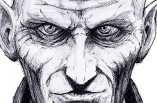



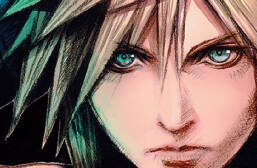
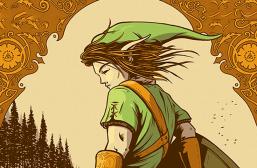

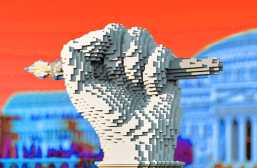
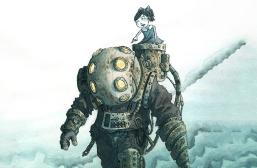


Do you get the feeling the whole concept of the game was taken from an acid trip?
I love this game.
It should be noted that this game never came out in PAL regions. It’s sad, I fell in love with Katamari the first time I played the We <3 Katamari demo and I would've loved to play the first game when it came out.
I had no idea there was never a PAL release. I’m honestly surprised it got a US release.
I really enjoyed your article, your arguments for the game’s world housing a flat ontology are very convincing, but I don’t know if I agree with your conclusion. You claim that Katamari is inherently a game about deconstruction, but the main mechanic and narrative driving point in the game is consumption. Your argument here is that “the katamari, removes object A from its existence inside and as a part of object B” but you neglect to mention that object A is then recontextualized as a part of object C, the Katamari. Object A doesn’t cease to exist, it is consumed by another object. I’ve always taken the main theme of the Katamari games to be a kind of senseless consumption, a reflection of materialist society.
The game claims its goal as the creation of a star, but the star is only briefly shown to the player and then it spends the rest of its days acting only as a trophy that the player can look back at. The real meat of the game is in the act of consumption the player goes through. The reward lacks meaning. The game drives this point home when you play a level again and are given the choice to simply destroy the Katamari, reducing it to stardust. It doesn’t matter that you picked up all that stuff, its gone, never to be seen again.
I don’t think the game says much about deconstruction because nothing is really even destroyed. You can always go back to to the level and find all of the objects there as pristine as the first time you played. Everything is fresh and new again, ready for you to pick up and hold onto. Even if you only hold on for a brief time.
“The game drives this point home when you play a level again and are given the choice to simply destroy the Katamari, reducing it to stardust. It doesn’t matter that you picked up all that stuff, its gone, never to be seen again.”
This is interesting, and key.
I have to say, I’ve always found the style of Katamari so interesting. This article was definitely a good find! Have you ever played the “Wonderful End of the World” for PC? It is a similar game developed by Dejobaan Games that plays a lot like Katamari!
I’ll definitely check it out. Ben Esposito’s new game Donut Country also looks really interesting. It’s more or less an anti-Katamari.
This game is a nonsensical clusterfuck of awesome! I still play it a lot
The music is awesome
This was a colourful analyses, just like the game itself.
I just don’t get it. I don’t get the love for this game. So many other gamers have tried to turn me on to this game, and I can’t get into it. It’s far too bright, colorful and cutesy for me. And the gameplay is boring as far as I’m concerned.
I remember playing the game on my sister’s husband’s (then boyfriend) iPod touch. It was probably one of the most challenging games I’ve played so far then (but perhaps I was just terrible at the game- who knows?). Moving on to the PSP version sometime later, one of the things that kept me addicted to it was the prospect of being able to collect the other Katamari wherever they appeared but oh- the amounts of times I simply gave up because things got too hard… with a heavy heart I decided to let the game go for good.
I just found this article, and I love the analysis you did! Enjoyable read
Good articulation of the game’s treatment of objects – in the ten years following my first play-through of Katamari Damacy, I never once was able to pinpoint exactly what was strange about the game’s environment, at least not as specifically as you have done here. It reminds me of another game I was playing around the time – Garry’s Mod. When Garry’s Mod was first released, I found it very novel because I had already played through Half-Life 2, and familiarized myself with the objects, characters, and settings as they appear in the narrative. To be able to take them out of context and manipulate them every which way was a totally unexpected experience. It does the same thing for the objects of that game as Katamari does for everyday objects in general.
I’ve never thought of Katamari in this sense, but it makes a ton of sense. Kind of gives you a new outlook when you’re rolling up objects all around the world.
I’ve always thought of Katamari as a buddhist/nihilist take on materialism– I mean, look at the Houses, Streets, Cities. They’re all full of useless things, inifinite number of the most variety of objects, people living in this world on the brink of collapsing under the weight of its own. Even people are trapped in the katamari, but we never think of them as people, the game only shows us this robot-like beings, living their lives like they move on rails, automatic. Only the interuption of the Katamari (their own personal doom, soon they’ll find out) seems to make them react in any sort of way. The task of the Prince is to take us from the world full of objects (representation of earthly wants and desire) to a literal “higher plane” of existence, were we burn, yes, but we burn as a beautiful, everlasting star in the sky.